Attached files
| file | filename |
|---|---|
| 8-K/A - FORM 8-K/A - Kior Inc | d824230d8ka.htm |
Exhibit 17.1
Hoevelaken, August 31st 2014
LETTER OF RESIGNATION
| From: | Paul O’Connor | |
| To: | The board of directors of KiOR Inc. | |
Dear fellow directors
As you know the KiOR technology to convert waste biomass into fuels and chemicals via catalytic pyrolysis (or cracking) originated from a Dutch company called BIOeCON, which invented and explored this concept in 2006 and 2007. I am one of the principal inventors of this technology. Other key inventors are Prof’s Avelino Corma, Jacob Moulijn, Dr. Dennis Stamires, Dr. Igor Babich and Sjoerd Daamen B.Sc. all working and cooperating with BIOeCON since early 2006.
At the end of 2007 BIOeCON and Khosla Ventures (KV) formed KiOR Inc., whereby BIOeCON contributed the technological ideas and the IP, and KV the funding. In 2008 at my suggestion KiOR hired Fred Cannon as their CEO. Fred Cannon had been my boss earlier at Akzo Nobel and Albemarle and I valued Fred for his excellent people skills. During the Akzo years I worked very close with Fred, whereby I lead the technology development together with 2 other colleagues (One of them Dr. Hans Heinerman, who also worked for KiOR in 2008-2009). Fred was always able to get the financial support from the Akzo Nobel board for the funding so we could execute our innovative projects, which greatly enhanced the profitability and value of the Akzo Nobel Catalyst group.
During the first two years of KiOR 2008-2009, I worked as CTO with Fred in building up the organization, proving the concept in a modified FCC pilot plant and leading the research into improved catalysts. Already then we had some technical disagreements about the road forward and managerial issues about the experience and quality of the people being hired. Unfortunately Fred broke off the links to the BIOeCON origin of the technology and so KiOR lost some very valuable experience and insights from the strong European experts connected with BIOeCON. My two-year contract, as CTO was not renewed in October 2009. I did stay on the board of KiOR, until May of 2011. During this period on the board my access to technical information was restricted and limited as the MT and Khosla Ventures were uneasy about my known other activities in the area of biomass conversion in cooperation with PETROBRAS. This cooperation by the way is outside of the KiOR scope as was agreed with Khosla Ventures during the formation of KiOR.
Initially I was not too concerned about the further development of KiOR technology as one of the few figures presented to the board of directors in February of 2011 (See Attachment A) indicated some good progress in increasing the yields in gallons per ton. At the end of 2011 however, I received some additional data (See attachment B) and I was shocked to see that the yields were lower than reported in February (and then projected in the S-1) and that hardly any progress had been made since the end of 2009. I immediately informed KiOR’s CEO, Fred Cannon and Samir Kaul (Director for Khosla Venture, as BIOeCON’s partner and main shareholder of KiOR) about my concerns regarding the limited improvements achieved. After several e-mail and phone discussions with Fred Cannon and Samir Kaul, I received the opportunity to visit KiOR for a
1
technology review. Unfortunately the review was very restricted and limited. Still with the limited data made available to me during my review I could conclude that part of the problem of the lower yields, was the lower than expected oil recovery from the oil-water separation. My main conclusions were:
QUOTE
| • | The present overall yield of saleable liquid products, roughly estimated from the information received falls short of the targets set for 2012 (= 67 gallons per ton bone dry wood, GPBD) and has not improved significantly over the last two years. |
| • | It is possible to reach the target of 67 GPBD and possibly even also the long term target of 90 GPBD, but this will require a drastically different approach, than presently being pursued by R&D. |
UNQUOTE
The full report and relevant correspondence is included as Attachment C.
At the last board meeting where I was present (April/May 2012) the R&D director after a Technology Update, under questioning by myself admitted that we should not expect to reach the 67 GPBD at Columbus, but possibly at the next commercial plant including further reactor modifications. I estimated that based on the R&D data given to me at that time, that the real yields for Columbus would be closer to 30-40 GPBD. Unfortunately none of my recommendations was followed up.
It is obvious for all of us today that KiOR is going through some difficult times, and may even not survive as a company. The reason for this, in my opinion, is not because of the failure of the technology itself, but because of several wrong choices made during the development and commercialization of the technology. Over the years there have been several warning signals (internal & external), one of which as I mentioned in the foregoing has been my own technology audit report in March/April of 2011. Notwithstanding these warnings KiOR’s MT continued on their set course. In mean time everyone else hoped for the best.
After the mechanical completion of the Columbus plant it took quite a long time, before the plant actually started producing products. Of course I was concerned and in preparation of the Annual shareholders meeting in May 2013, I sent a letter to Fred Cannon asking some important questions (Attachment D). At the annual meeting I had a separate meeting with Fred and Samir Kaul. Fred’s response was that I was too negative: “We (= KiOR) have made tremendous progress in the last 18 months in R&D”
The real proof-of-the-pudding however would be a successful start-up and operation of Columbus in 2013. Unfortunately this did not work out the way, which everyone had hoped for and several problems were encountered leading to production rates of about only 10% of the actual design case. The first impression was that this was related to “normal” start-up issues. After an audit requested by the KiOR board and Khosla Ventures in November of 2013 it became clear however that the product yields were in fact much lower than projected (±30 in stead of 70 gallons/ton), while the on-stream times were also way too low (less than 50%).
2
Around that time the KiOR board (via Will Roach and Samir Kaul) approached me to help KiOR as a technical expert in reviewing the situation at KiOR and in January of 2014 I signed an NDA and started reviewing the data from Columbus and R&D. My observation was that the low yields and on-stream times at Columbus were reasonably in line with the results and experience in the DEMO plant in Houston. This means that the main problems at Columbus are already discernable in the DEMO operations and are therefore structural and not “just” operational issues. My belief then and still now is, that these problems can be solved, but that this will require a different approach in catalyst selection and operation strategy. I have stressed to the board that in my opinion a clear change (Plan B/Re-set) in technology strategy as well as leadership style (gOpenness & Transparency) is essential to solve the issues. I reported this to Will Roach and the board in early February.
Near the end of March you as KiOR board asked me to join the board and to assist as a technical advisor, while I would be empowered to lead a taskforce of KiOR’s R&D and technology to address and solve the existing issues in KiOR’s technology.
I started forming this taskforce in April, with apparent approval of the MT, after making some difficult compromises with the MT, as the MT still had very different views on how to improve the technology. These different views resulted in strong differences of opinions with regards to the priorities to be given, the organization, people decisions etc. I persisted with my task and returned to Houston after a short stay in Europe in May. I was then requested by the board to postpone my visits to KiOR, because of my critical attitude towards the MT (sic). This meant that my efforts to lead the taskforce and make the necessary changes at KiOR stopped: In my opinion KiOR hereby lost some crucial months and also some good people. I tried to meet with the MT to reestablish a mode of working together, but the MT did not respond.
In the mean time KiOR has started a marketing process (via Guggenheim) to explore investment and/or sale opportunities for the company. This is a good initiative, as it may help to salvage this interesting and promising technology. However, it is also my conviction that in order to maximize the value and “survivability” of KiOR, KiOR should use the time and funds still available, to focus on the alternative approaches that I have proposed, which I believe will be able to prove on the DEMO scale that the yields and on-stream times of KiOR technology can be substantially improved.
Unfortunately the MT is still not receptive to this and has distributed, what I believe are poorly substantiated projections for Guggenheim to pitch KiOR to potential investors and/or buyers. These projections do not include the crucial learning’s from the DEMO and Columbus. Keep in mind that the MT also convinced the board at the time to build and start-up Columbus based on projections, which have not been substantiated in the DEMO, while we now know that the DEMO predicted reasonably well the poor yields and on-stream times at Columbus. As already communicated to you earlier I cannot support this approach.
Concluding:
I am of the opinion that KiOR’s MT professionally has not performed in evolving the KiOR technology to a commercial success; furthermore the MT in my opinion has not provided the board of directors of KiOR with the adequate, right and relevant information to do their job. I therefore am of the opinion that the MT needs to resign and to be replaced in order to improve the chances of success of KiOR and/or any other potential new ventures based on KiOR technology in the future.
3
In the mean time, as I do not have the opportunity to help KiOR as originally intended, I have resigned from the board as of August 31st 2014. Although I am no longer on the board, I remain a strong supporter of KiOR technology and the company and hope you as board will wisely decide on the future of KiOR.
Very best regards
/s/ Paul O’Connor
31 Aug 2014
Paul O’Connor
Attachments
4
APPENDIX A

KiOR
R&D Update
John Hacskaylo
February 2011
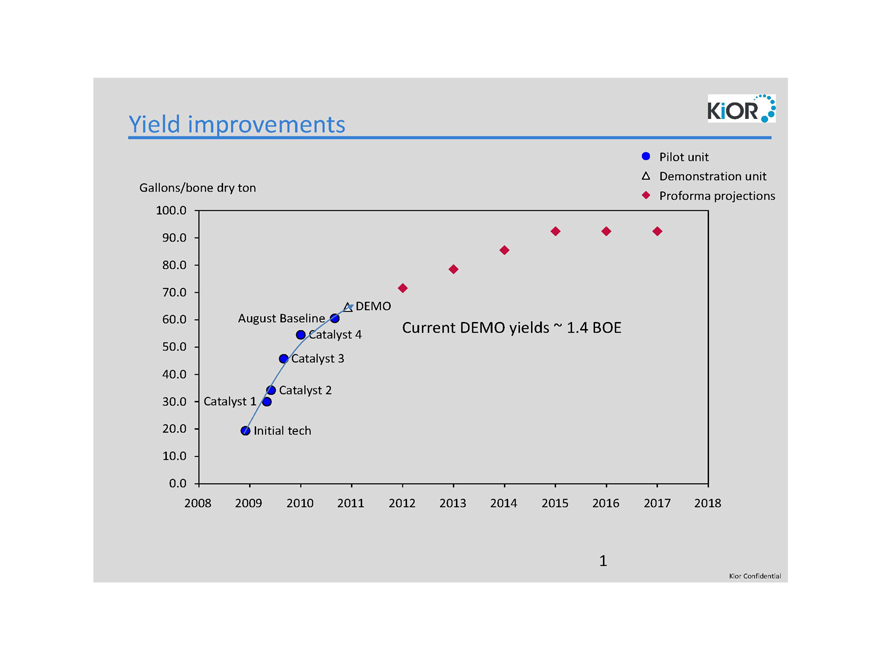
Yield improvements
Pilot
unit
Demonstration unit
Proforma projections
Gallons/bone dry ton
100.0
90.0
80.0
70.0
60.0
50.0
40.0
30.0
20.0
10.0
0.0
2008
2009
2010
2011
2012
2013
2014
2015
2016
2017
2018
DEMO
August Baseline
Catalyst 4
Catalyst 3
Catalyst 2
Catalyst 1
Initial tech
Current DEMO yields ~ 14 BOE
1
Kior Confidential
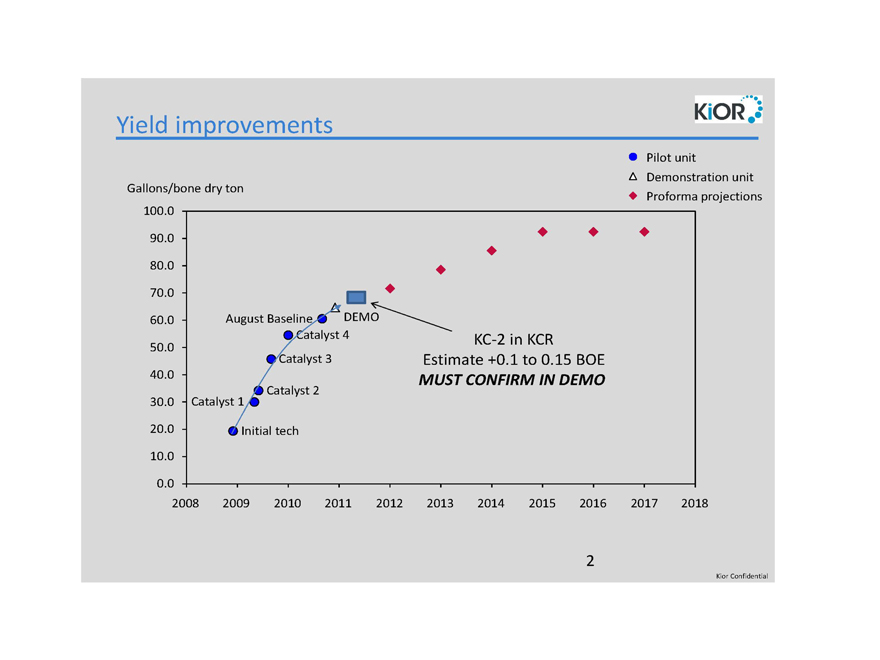
KiOR
Yield improvements
Gallons/bone dry ton
Pilot unit
Demonstration unit
Proforma projections
100.0
90.0
80.0
70.0
60.0
50.0
40.0
30.0
20.0
10.0
0.0
2008 2009 2010 2011 2012 2013 2014 2015 2016 2017 2018
August Baseline
DEMO
Catalyst 4
Catalyst 3
Catalyst 2
Catalyst 1
Initial tech
KC-2 in KCR
Estimate +0.1 to 0.15 BOE
MUST CONFIRM IN DEMO
2
Kior Confidential
APPENDIX B

KiOR
Technology Update
Board of Directors Meeting
December 15, 2011
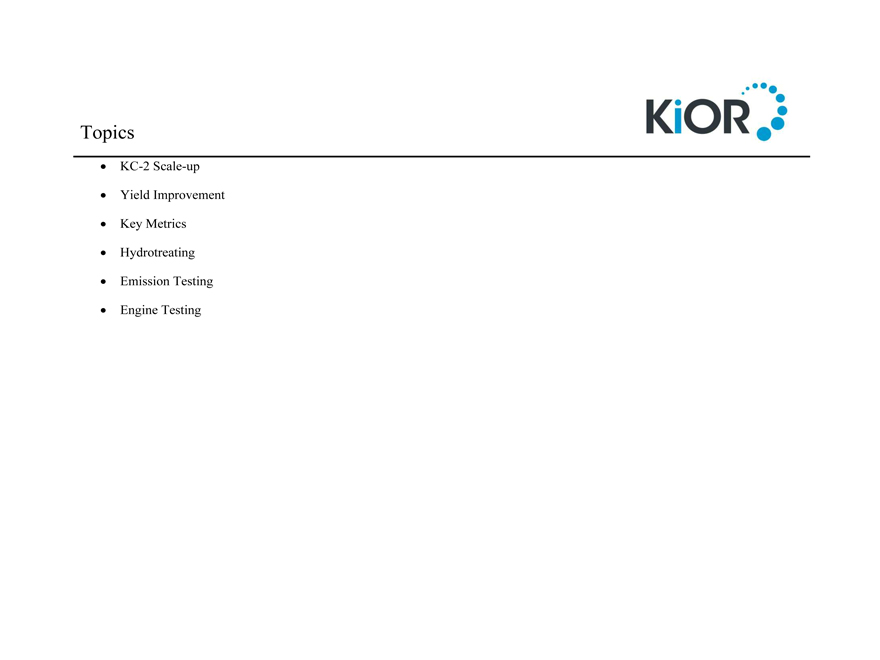
KiOR
Topics
KC-2 Scale-up
Yield Improvement
Key Metrics
Hydrotreating
Emission Testing
Engine Testing
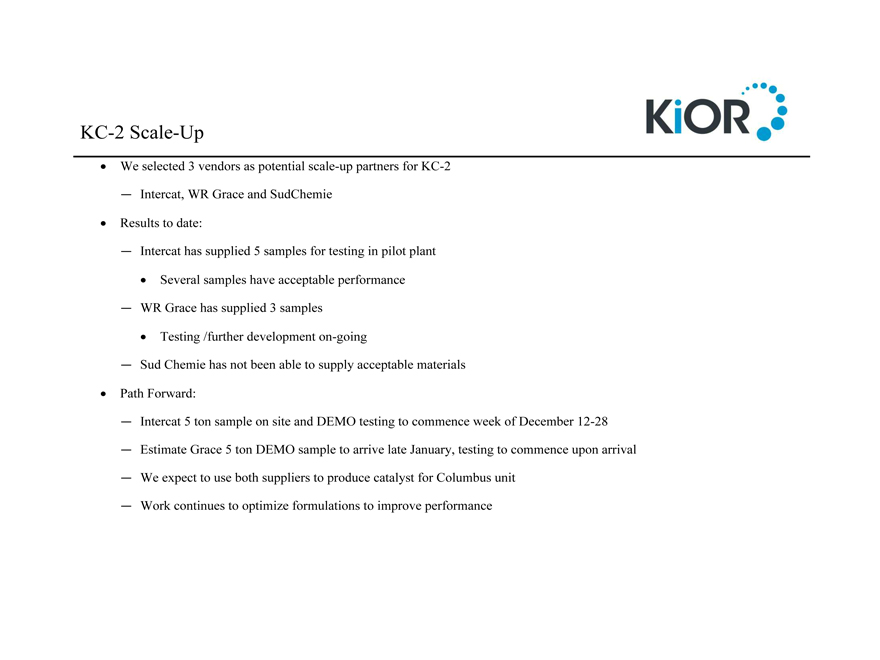
KC-2 Scale-Up
KiOR
We selected 3 vendors as potential scale-up partners for KC-2
- Intercat, WR
Grace and SudChemie
Results to date:
- Intercat has supplied 5 samples for
testing in pilot plant
Several samples have acceptable performance
- WR Grace
has supplied 3 samples
Testing /further development on-going
- Sud Chemie has
not been able to supply acceptable materials
Path Forward:
- Intercat 5 ton
sample on site and DEMO testing to commence week of December 12-28
- Estimate Grace 5 ton DEMO sample to arrive late January, testing to commence upon arrival
- We expect to use both suppliers to produce catalyst for Columbus unit
-
Work continues to optimize formulations to improve performance
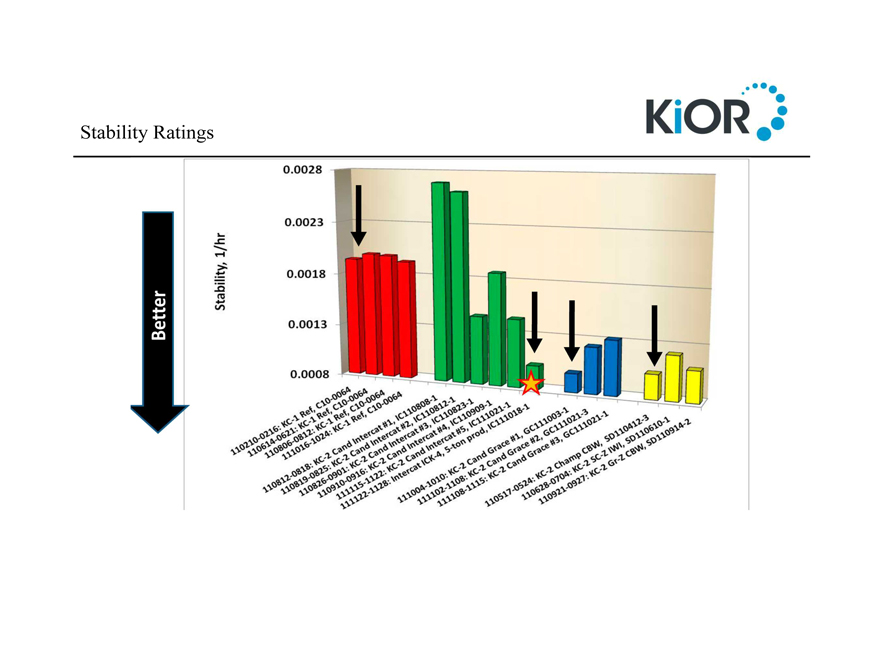
KiOR
Stability Ratings
Stability, 1/hr
0.0028
0.0023
0.0018
0.0013
0.0008
Better
110210-0216: KC-1 Ref, C10-0064
110614-0621: KC-1 Ref, C10-0064
110806-0812: KC-1 Ref, C10-0064
111016-1024: KC-1 Ref, C10-0064
110812-0818: KC-2 Cand Intercat #1, IC110808-1
110819-0825: KC-2 Cand Intercat #2, IC110812-1
110826-0901: KC-2 Cand Intercat #3, IC110823-1
110910-0916: KC-2 Cand Intercat #4, IC110909-1
111115-1122: KC-2 Cand
Intercat #5, IC11021-1
111122-1128: Intercat ICK-4, 5-ton prod, IC111018-1
111004-1010: KC-2 Cand Grace #1, GC111003-1
111102-1108: KC-2 Cand Grace #2,
GC111021-3
111108-1115: KC-2 Cand Grace # 3, GC111021-1
110517-0524: KC-2
Champ CBW, SD110412-3
110628-0704: KC-2 SC-Z IWI, SD110610-1
110921-0927:
KC-2 Gr-Z CBW, SD110914-2

KiOR
BOE @ 120 Hrs
BOE-15 @ 120 hrs
110210-0216: KC-1 Ref, C10-0064
110614-0621: KC-1 Ref, C10-0064
110806-0812: KC-1 Ref, C10-0064
111016-1024: KC-1 Ref, C10 0064
110812-0818: KC-2 Cand Intercat #1, IC110808-1
110819-0825: KC-2 Cand Intercat #2, IC110812-1
110826-0901: KC-2 Cand Intercat #3, IC110823-1
110910-0916: KC-2 Cand Intercat #4, IC110909-1
111115-1122: KC-2 Cand
Intercat #5, IC111021-1
111122-1128: Intercat ICK-4, 5-ton prod, IC111018-1
111004-1010: KC-2 Cand Grace #1, GC111003-1
111102-1108: KC-2 Cand Grace #2,
GC111021-3
111108-1115: KC-2 Cand Grace #3, GC111021-1
110517-0524: KC-2
Champ CBW, SD110412-3
110628-0704: KC-2 SC-Z IWI, SD110610-1
110921-0927:
KC-2 Gr-Z CBW, SD110914-2
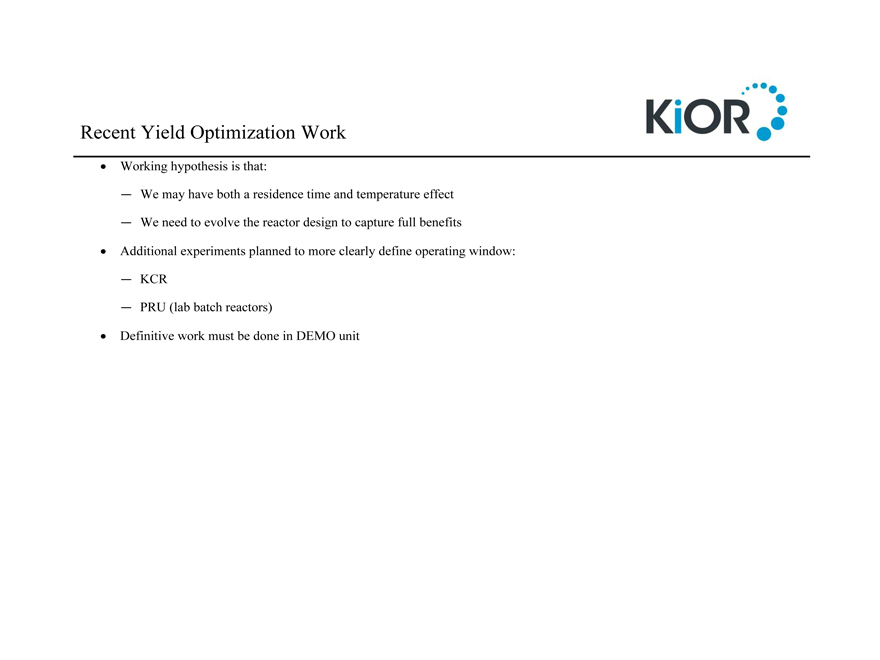
KiOR
Recent Yield
Optimization Work
Working hypothesis is that:
- We may have both a residence
time and temperature effect
- We need to evolve the reactor design to capture full benefits
Additional experiments planned to more clearly define operating window:
- KCR
- PRU (lab batch reactors)
Definitive work must be done in DEMO unit
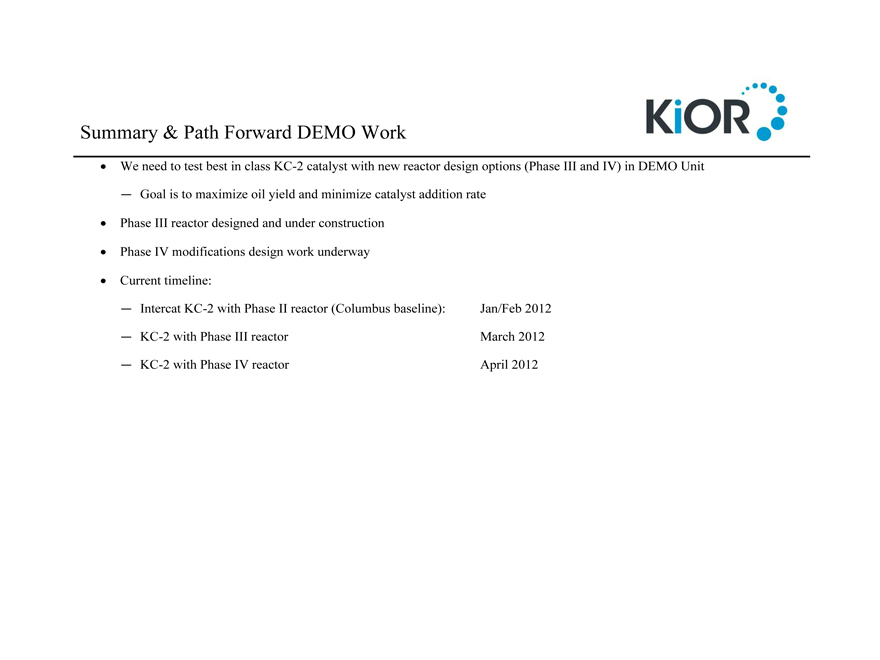
KiOR
Summary & Path
Forward DEMO Work
We need to test best in class KC-2 catalyst with new reactor design options (Phase III and IV) in DEMO Unit
- Goal is to maximize oil yield and minimize catalyst addition rate
Phase III reactor designed
and under construction
Phase IV modifications design work underway
Current
timeline:
- Intercat KC-2 with Phase II reactor (Columbus baseline): Jan/Feb 2012
- KC-2 with Phase III reactor March 2012
- KC-2 with Phase IV reactor April 2012

KiOR
Coke Selectivity
Improvement in KCR Pilot Plant
17.5
17 Current
16.5
16
15.5
15
14.5
Coke wt %
Oct-11
Jan-12
Apr-12
Jul-12
Oct-12
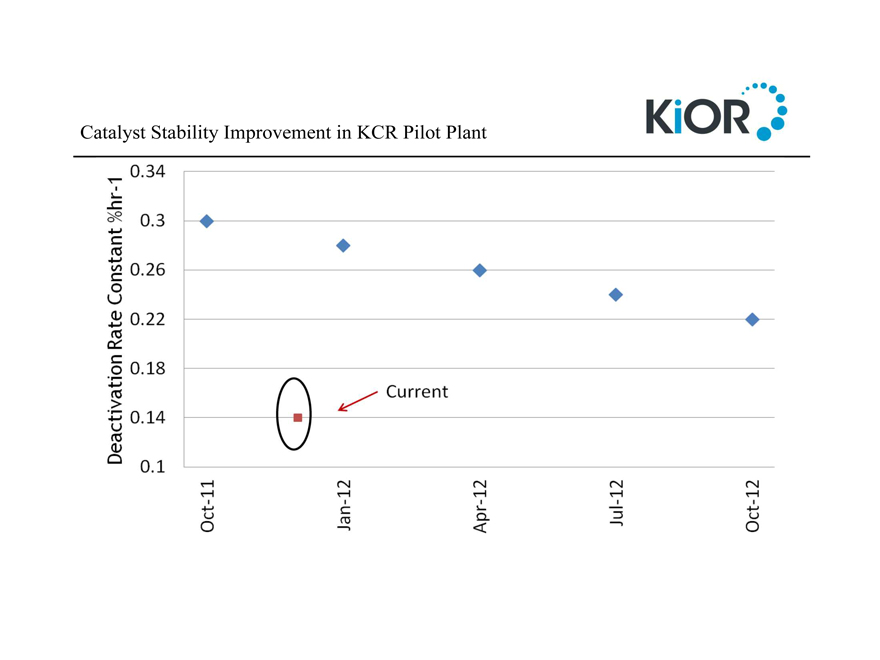
KiOR
Catalyst Stability
Improvement in KCR Pilot Plant
0.34
0.3
0.26
0.22
0.18
0.14 Current
0.1
Deactivation Rate Constant %hr-1
Oct-11
Jan-12
Apr-12
Jul-12
Oct-12
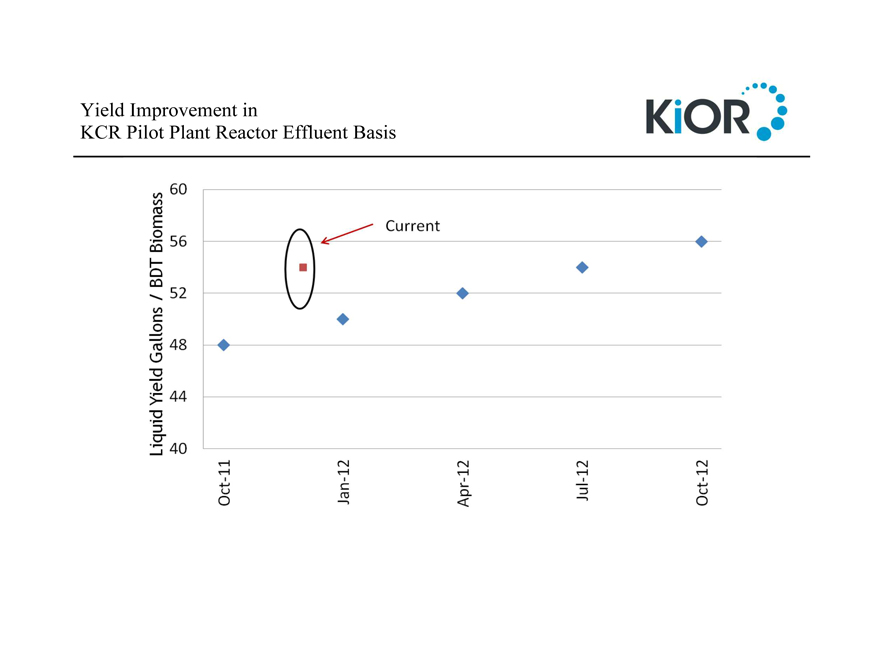 Yield Improvement in
Yield Improvement in
KCR Pilot Plant Reactor Effluent Basis
KiOR
Liquid Yield Gallons / BDT Biomass
Current
60 56 52 48 44 40
Oct-11 Jan-12 Apr-12 Jul-12 Oct-12
 Yield Improvement in
Yield Improvement in
KCR Pilot Plant Reactor Effluent Basis
Liquid Yield Gallons / BDT Biomass
Expected DEMO Performance
Optimized Phase III/IV Reactor
Current Pilot Plant
KCR Pilot Plant
68 64 60 56 52 48 44 40
Oct-11 Jan-12 Apr-12 Jul-12 Oct-12
 Hydrotreating Summary
Hydrotreating Summary
KiOR
Pilot plant units
2 Kior, 1 contract ( PARC) started Q3, 2010
> 35, 000 hrs , > 1400 gallons products
Demonstrated ability to produce good products
Characterization, certification, customer sampling
Established main operating
and feedstock parameters
Next steps to broaden and optimize performance
Demonstration unit
Better data for start-up, operating and scale-up issues
Heat release, catalyst performance, material balances
Larger quantities for
testing and customer sampling
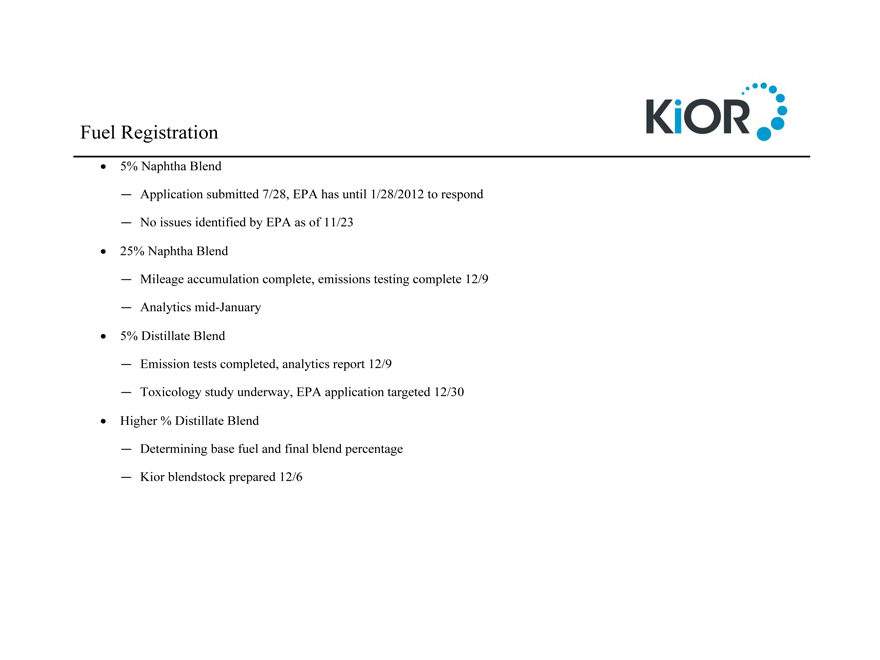 Fuel Registration
Fuel Registration
KiOR
5% Naphtha Blend
Application submitted 7/28, EPA has until 1/28/2012 to
respond
No issues identified by EPA as of 11/23
25% Naphtha Blend
Mileage accumulation complete, emissions testing complete 12/9
Analytics mid-January
5% Distillate Blend
Emission tests completed, analytics report 12/9
Toxicology study underway, EPA application targeted 12/30
Higher % Distillate
Blend
Determining base fuel and final blend percentage
Kior blendstock
prepared 12/6
 “No Harm” Engine & Materials Testing
“No Harm” Engine & Materials Testing
(Not required but proactive for stakeholders)
KiOR
TEST S (Naphtha examples) METHODS
SwRI Intake Valve Deposit Screening
Port Fuel Injector Screening
Material Compatibility
Intake Valve & Comb. Chamber Deposits
2-Stroke Wear, Smoke & Exhaust Port Bench Test Complete Bench Test Complete Bench Test Engine Dynamometer Engine Dynamometer
GM, BMW and Chrysler Specific Tests Vehicles
Analogous Tests For Distillate Blends
Comparison Of Industry Blends
Survey Of 10 Commercial ULSD’s
Higher BTU Content Example
BTU (net) with Reproducibility Bands
BTU/Gal, D240
138000
136000
134000
132000
130000
128000
126000
124000
122000
120000
Distillate
MS - ULSD
MS - 5% KiOR
AL - ULSD
AL - 5% KiOR
TN - ULSD
TN - 5% KiOR
NJ - ULSD
NJ - 10% KiOR
FL - ULSD
FL - 10% KiOR
MI - ULSD
MI - 10% KiOR
Source of Fuel Samples:
SwRI analyzed 6 commercial ULSDs from 6 U.S. cities, October 2011
APPENDIX C1
CONFIDENTIAL
KiOR Technology Assessment - March 2012
By Paul O’Connor, March 22nd 2012.
Background
On March 8th at the invitation of Fred Cannon (CEO) I visited KiOR to discuss my concerns about the in my mind the limited improvements in the overall process yields obtained over the last 2 years.
My concerns were based on the scarce and conflicting information on product yields I received during the board of director meetings (BOD) in the period of 2009 up to 2011 [See Appendix 1]. These concerns are further amplified given the fierce, rapidly evolving and well-funded competitive technologies in this space. One example is the JV between Ensyn and UOP.
The following assessment is based on limited additional information I received during the meeting and presentations at KiOR on March 8th, and is constrained by the following limitations:
| 1) | I requested, but did not receive the “raw” actual pilot plant and demo plant yields to be able to check the validity of the data presented to me. |
| 2) | I asked, but was not given the opportunity for private one-to-one interviews with key technical personnel, who actually perform the work. |
| 3) | I did not receive answers to several critical questions asked during and after my visit to KiOR [See Appendix 2] |
| 4) | I asked, but was not allowed assistance from the in-house expert consultant, Prof Vasalos, to analyze and validate yield performance. |
| 5) | I was not given access to detailed information regarding the properties, handling, and the suitability of the raw bio-oil to be hydro-treated for upgrading. |
Observations
Notwithstanding the foregoing it is still possible for me to make the following observations:
| 1) | The KiOR management team has made excellent progress in building the organization and scaling up the BCC process from the Pilot to the Demo phase and now also the commercial phase (Columbus plant) in a record time of less than 5 years, considered impossible in the process industry. |
| 2) | The KiOR management and technical personnel feel confident that they can start up the Columbus plant in 2012 and produce good quality saleable products (Gasoline, Diesel, Low S Heavy Fuel Oil). |
| 3) | As can be expected, the major effort of R&D has been and still is in the scaling-up of the process and the catalyst and hence only limited effort has been spent on searching for the next breakthroughs. In fact the catalyst and reactor concepts presently being developed were already conceived in 2009. |
| 4) | The way in which product yields are being reported (e.g. to the BOD) by R&D management is incomplete and misleading and does not correspond with the actual goal of improving overall yield of saleable liquid products. |
| 5) | The present overall yield of saleable liquid products, estimated from the information received [See Table 1] falls short of the targets set for 2012 (= 67 gallons per ton bone dry wood, GPBD) and has not improved considerably over the last two years. |
| 6) | In my opinion it is still possible to reach the target of 67 GPBD and possibly even also the long term target of 90 GPBD, but this will require a drastically different approach, than presently being pursued by R&D [See recommendations] |
Table 1:
Estimates of overall saleable liquid product yield 2009-2012
| Date | Reactor Effluent | Oil Recovered | HT Vol Gain | Overall GPBD | ||||
| June 2009 | ||||||||
| KCR* | ~30-40* | ~5 | ~35-45 | |||||
| February 2011 | ||||||||
| KCR | ~65? | ~65 (100%)** | ~0 | ~65 | ||||
| Demo | ~65? | ~65 (100%)** | ~0 | ~65 | ||||
| December 2011 | ||||||||
| KCR | ~54 | ~40 (74%) | ~5 | ~45 | ||||
| Demo | ~58 | ~44 (75%) | ~5 | ~49 | ||||
| March 2012 | ||||||||
| KCR | ~45-55 | ~35 (70%) | ~5 | ~40 | ||||
| Demo** | ~55-65** | ~45 (75%) | ~5 | ~50 | ||||
| Columbus 4Q2012? | ||||||||
| Best Case | ~65** | ~60 (92%)** | ~10 | ~70 | ||||
| Worst Case | ~50 | ~35 (70%) | 0 | ~35 | ||||
Notes:
| *) | Based on ~20% actual liquid oil yield at ~10% Oxygen yielding ~1% BOE =42 GPBD |
| **) | Remains unconfirmed, limited data; question [Appendix 2] if this is real data or “just” a model extrapolation estimate? |
Recommendations
To achieve these very challenging goals, KiOR needs two separate and individual teams as follows:
Team 1: Technology Optimization KiOR-1G
Implementation and optimization of the present demo-phase ideas/concepts being an improved KC-2 catalyst and an improved 3/4G reactor, technical plant support, in combination with significant improvements in the oil recovery (amongst others in the water-oil separation) in order to ensure overall yield in 60-70 GPBD bracket by late 2012 or early 2013. This includes further hydro-treating technology development and interfacing/screening catalysts supplied by the different vendors for use in the commercial plants.
Team 2: Technology Breakthrough KiOR-2G, next-Gen
Develop the next generation catalysts and/or reactor design necessary to move the overall yield up to the 90-100 GPBD bracket. Includes development of new more effective, less costly, catalysts as well as development of new concepts in the production of bio-crude and its upgrading to fuels.
It is of essence that the two teams are separately managed, with separate resources and facilities, and that the teams will report separately and directly to the CEO and BOD.
Team 1 will in a certain sense be a continuation of the present R&D activities, albeit significant improvements still need to be achieved in unifying the team and in communications with all other departments
Team 2 will be a completely new effort and should involve a very creative Discovery Team (DT) with dedicated resources, staffed with scientists and engineers with experience in the “field” and managed by an established, well respected expert
My estimate would be that of the present 60 FTE’s R&D about 90% will be in Team 1 and about 10% in Team 2 not including new hires with the above mentioned expertise
Furthermore to assist, advise and monitor the two teams, my recommendation is to form a Technical Advisory Board (TAB) consisting of world recognized specialists. Monthly separate progress meetings of the TAB with both teams will be required. The TAB will report directly to the CEO and BOD.
Appendix 1 R&D Presentations
1) BOD February 2011 by John Hacskaylo

2) BOD December 2011 by John Hacskaylo
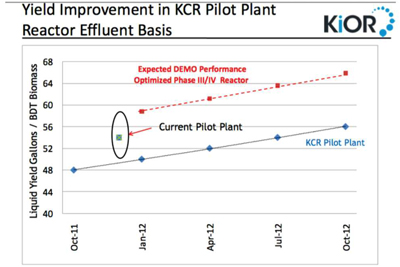
Appendix 2 Follow up questions
Further to my visit and our telephone conversation on Monday, I would like additional information/data to continue with my analysis and assessment to the BoD:
1) Actual performance data from the Demo Plant.
Reactor effluent oil yields (BOE or GPBD) and oxygen content (%) as a function of time since demo start up, including % oil in water and % of light gases. (No info on reactor or catalyst necessary).
2) Best estimate you have today on % oil recovery to calculate the “Overall product yield” from the reactor effluent yield (without including the amount of oil in the water and also without including the light gases)
At present I am guessing about ~ 70%?
3) Provide detailed information on assumptions and calculations of the $ 1.80 / gallon product cost for a 1500 ton/day plant @ 67? GPBD yield
4) List of abandoned patents (~28) of which I am a co-inventor
APPENDIX C2
From: Paul O’Connor <paul.oconnor@bio-e-con.com>
Subject: Follow up questions - KiOR Review
Date: March 15, 2012 6:46:45 AM PDT
To: Fred Cannon <fred.cannon@kior.com>
Dear Fred
Further to my visit and our telephone conversation monday, I would like some additional information/data to round of my feedback to the board:
1) Actual performance data from the Demo Plant.
Reactor effluent oil yields (BOE or GPBD) and oxygen content (%) as a function of time since demo start up (No info on reactor or catalyst necessary).
2) Best estimate you have today on % oil recovery to calculate the “Overall product yield” from the reactor effluent yield.
At present I am guessing about ~ 70%?
3) Your assumptions and calculation of the $ 1.80 / gallon product cost for a 1500 ton/day plant @ 67? GPBD yield
4) List of abandoned patents (~28) of which I am a co-inventor
I will contact Samir to see how he wants to discuss this at the board.
I agree with you that an Oral presentation is the best.
Best regards
Paul
Paul O’Connor
BIOeCON
Hogebrinkerweg 15e
3871KM Hoevelaken, The Netherlands
Office: +31 33 254 0473
Cell: +31 64 173 4842
paul.oconnor@bio-e-con.com
www.bio-e-con.com
APPENDIX C3
STRICTLY CONFIDENTIAL
KiOR Technology R&D: Assessment & Recommendations
By Paul O’Connor - April 21st 2012
As one of the few directors of KiOR with a technical background I feel I have a special responsibility to critically review the progress being made at KiOR in the fields of Technology and Research & Development.
Overall the information we have been receiving in the area of Technology and R&D as directors of the board has been very limited and very superficial.
In December last I expressed concerns about the limited improvements made in R&D related to the overall process yields. My concerns were based on scarce and conflicting data received during the board meeting in December. At the invitation of Fred Cannon (CEO) I visited KiOR early March to discuss these concerns, while after the BOD meeting of March 23rd the R&D Manager gave a very limited R&D overview to the directors present, which confirmed my opinion that the metrics presently being used to monitor R&D progress are inadequate.
The following assessment is based on limited information received during the meeting and presentations at KiOR on March 8th, and the presentation of the R&D Manager on March 23rd and is constrained by the following limitations:
| 1) | I did not receive the “raw” actual BCC and BCC HT oil hydro-treater pilot plant and demo plant yields. |
| 2) | I was not given the opportunity for private one-to-one interviews with key technical personnel. |
| 3) | I did not receive answers to several critical follow-up questions asked during and after my visit. |
| 4) | I was not allowed assistance from an expert consultant, to analyze and validate the BCC and BCC HT process performance in depth. |
| 5) | I was not given any information on the bio-oil/water separation. |
| 6) | I was not given access to detailed information regarding the properties, handling, and the suitability of the raw BCC bio-oil to be hydro-treated for upgrading into saleable products. |
Therefore this review and assessment is very preliminary and should definitely not be considered as a full in depth technology audit.
Notwithstanding these limitations is still possible for me to report some key observations and recommendations.
Observations
| 1) | KiOR management team has made excellent progress in building the organization and scaling up the BCC process from the Pilot to the Demo phase and now also to the commercial phase (Columbus plant) in a record time of less than 5 years, considered impossible in the process industry. |
| 2) | KiOR management feels confident that they can start up the Columbus plant in 2012 and produce good quality saleable products (Gasoline, Diesel, Low S Heavy Fuel Oil). |
| 3) | As can be expected, the major effort of R&D has been and still is in the scaling-up of the process and the catalyst and hence only limited effort has been spent on searching for the next breakthroughs. In fact the catalyst and reactor concepts presently being developed were already conceived in 2009. |
| 4) | The way in which overall product yields are being reported by R&D management is incomplete, inadequate and misleading and does not correspond with the actual business goal of improving the overall yield of saleable liquid products. |
| 5) | The present overall yield of saleable liquid products, roughly estimated from the information received falls short of the targets set for 2012 (= 67 gallons per ton bone dry wood, GPBD) and has not improved significantly over the last two years. |
| 6) | It is possible to reach the target of 67 GPBD and possibly even also the long term target of 90 GPBD, but this will require a drastically different approach, than presently being pursued by R&D. |
Recommendations
To the CEO
| 1. | Appoint a strong and knowledgeable CTO to effectively lead the important development efforts still required by R&D and Technology. |
| 2. | Review and adapt the performance metrics being used by R&D to correspond with the actual business goal of improving the overall yield of saleable liquid products |
| 3. | Replace the existing R&D Director. His lack of relevant knowledge is exemplified by his poor reporting of inadequate and even misleading metrics. He has demonstrated not to have the right competences and skills to ensure R&D progress over the last 1-2 years. |
| 4. | Establish a separate Discovery Team with dedicated resources, staffed with scientists and engineers with experience in the field and managed by an established, well respected expert reporting directly to the CEO and/or CTO. |
To the Board of Directors (BOD)
| 1. | Appoint a knowledgeable independent team reporting to the BOD to perform a true in-depth technology review, without the limitations that constrained my present assessment. |
| 2. | Establish a Board Technology Committee (similar to the existing Audit committee) to review the technological progress on a regular basis. |
| 3. | Establish a Technical Advisory Board (TAB) consisting of world recognized experts and specialists to advise and assist the CEO, CTO and Board Technology Committee with its tasks (e.g. technology auditing) |
Table 1:
Estimates of overall saleable liquid product yield 2009-2012
| 1) Date | 2) Reactor Effluent | 3) Oil Recovered | 4) HT Vol Gain | 5) Overall GPBD | ||||
| 6) June 2009 | 7) | 8) | 9) | 10) | ||||
| 11) KCR* | 12) | 13) ~30-40* | 14) -5 | 15) ~35-45 | ||||
| 16) | 17) | 18) | 19) | 20) | ||||
| 21) February 2011 | 22) | 23) | 24) | 25) | ||||
| 26) KCR | 27) ~65? | 28) ~65 (100%)** | 29) ~0 | 30) ~65 | ||||
| 31) Demo | 32) ~65? | 33) ~65 (100%)** | 34) ~0 | 35) ~65 | ||||
| 36) | 37) | 38) | 39) | 40) | ||||
| 41) December 2011 | 42) | 43) | 44) | 45) | ||||
| 46) KCR | 47) ~54 | 48) ~40 (74%) | 49) ~5 | 50) ~45 | ||||
| 51) Demo | 52) ~58 | 53) ~44 (75%) | 54) ~5 | 55) ~49 | ||||
| 56) | 57) | 58) | 59) | 60) | ||||
| 61) March 2012 | 62) | 63) | 64) | 65) | ||||
| 66) KCR | 67) ~45-55 | 68) ~35 (70%) | 69) ~5 | 70) ~40 | ||||
| 71) Demo** | 72) ~55-65** | 73) ~45 (75%) | 74) ~5 | 75) ~50 | ||||
| 76) | 77) | 78) | 79) | 80) | ||||
| 81) Columbus 4Q2012? | 82) | 83) | 84) | 85) | ||||
| 86) Best Case | 87) ~ 65** | 88) ~60 (92%)** | 89) ~10 | 90) ~70 | ||||
| 91) Worst Case | 92) ~ 50 | 93) ~35 (70%) | 94) 0 | 95) ~35 | ||||
| 96) Notes: |
| *) | Based on ~20% actual liquid oil yield at ~10% Oxygen yielding ~1% BOE = 42 GPBD |
| **) | Remains unconfirmed, limited data; question if this is real data or “just” a model extrapolation estimate? |
APPENDIX D1
| MEMO: | Towards a prosperous future for KiOR | |
| By Paul O’Connor - April 30th 2012 | ||
I would like to repeat myself by starting to congratulate Fred Cannon and the KiOR team, in particular Ed Smith for the timely and on budget completion of the first cellulosic biomass conversion plant in Columbus.
During my time at Akzo Nobel Fred and Ed delivered similar achievements in construction and commissioning of chemical plants, amongst other in Houston with the completion of the “CRUSADE” (Cost Reduction USA Damn Exciting) project, which saved Akzo’s FCC catalyst business in the USA. So once again: Congratulations!
Up to the completion of Columbus KiOR has been on time and budget with the delivery of her milestones, however unfortunately since then the success ratio has not been so dramatic, resulting in the following delays and shifts in performance targets:
A. The Columbus plant is not yet on-stream, and the suggestion is that it may take up to nine-months before the plant is completely on-stream and ramped up to its capacity at 85% utilization and product yields ( = x? GPDB).
B. The product yields are not at the 72 Gallons per bone dry wood as estimated at the IPO, and in fact the suggestion is that the 72 GPBD will only be reached in the larger (and modified?) Natchez plant.
C. The catalyst being used at Columbus is based on large quantities of an expensive zeolite (apparently public knowledge!) and the rumor is that no substantial costs reductions are to be expected.
E. Based on A, B and C the overall economics and cash flow of KiOR will be substantially less positive than estimated at the IPO etc. While KiOR management is holding the info on A, B and C confidential, the overall financial result is and will become more clearly visible.
D. Because of A, financing of Natchez plant has been delayed and so also start-up of Natchez has been shifted at least one quarter from 4Q 2014 to 1Q 2015.
The result of the foregoing has been a dramatic drop in the KiOR share value, hurting the interests of all it’s shareholders.
While I still fully believe in the benefits and the potentials of further development of KiOR’s technology, I am very concerned about the way the technology is being implemented. My strong impression is that KiOR’s management although very competent and successful in the construction and commissioning phase, lacks the people with experience, vision and leadership to move forward with necessary improvements of the technology (yield improvement and catalyst cost reduction) and operations (capacity, ramp-up and time on stream). This is hurting KiOR now and could in worst case even turn a potential success into a failure if no appropriate corrective action is taken.
This concern of mine is not new, and I have expressed it already for a while, also during my tenure as director on the KiOR board and an official memo to the board and management: “KiOR Technology R&D: Assessment & Recommendations” of April 21st 2012, one year ago. As far as I know these recommendations have not been followed up, while they remain at least just as relevant today as they were a year ago.
While I already for some time, no longer have any official function at KiOR and I do not have any non-public information of KiOR, I am regularly being approached by shareholders from BIOeCON heritage, but also by other institutional investors and the press, asking me critical questions, amongst others why I am not actively helping the KiOR team to solve their problems?
Keep in mind that the success or failure of KiOR is for me not only a financial issue, but also as main inventor one of honor. Although KiOR never properly acknowledges the origin and heritage of the technology: BIOeCON and myself as primary inventor, most informed outsiders are smart enough to figure that out.
I cannot just stand back and watch; As I see it now, the only thing I can really do is to ask critical questions at the annual shareholder meeting on the 30th of May next in Houston with the hope to get the ball moving in the direction of the corrective actions needed to speed up the transition towards a profitable and prosperous business.
I understand that US securities laws requires that any answers must be released to the public via press release, so I am sending the questions for KiOR management and/or board of directors before the quarterly report of May 9th, so that management and/or the board of directors has the option to include answers in the press release(s) of May 9th and/or in a second press release before or on the 30th of May.
Attached the questions, which I intend to raise at the shareholders meeting.
Separate to that, I would like the opportunity to present and discuss my thoughts on how to tackle the issues raised by these questions with CEO Fred Cannon and Samir Kaul as key representative of Khosla Ventures (the controlling shareholder) in the board of directors.
QUESTIONS for KiOR management at the shareholders meeting:
1)
KiOR has disclosed that the expected yield of 72 GPBD, mentioned at the IPO will be achieved in the Natchez plant. How sure is KiOR about that? What are the overall product yields achieved at present in the R&D pilot plant(s) the demo plant and at Columbus? and how and when does KiOR expect to reach the more ambitious target of 90 GPBD?
2)
Two of KiOR’s previous operations managers (Coates ad Lyle) have stepped down, leaving KiOR without a COO or VP Operations. The delay in starting up and getting Columbus on stream could be related to this lack of operational leadership. Does KiOR have sufficient high-level staff with sufficient operational hands-on experience in the FCC and HPC processes to start up and run Columbus and a second plant in Natchez.
3)
Does KiOR have a Scientific and/or Technological Advisory Board in place? How does KiOR ensure an independent technical audit of their R&D and Operations to ensure quality and progress in development?
4)
When does KiOR expect to have the financing of the Natchez plant finalized?
